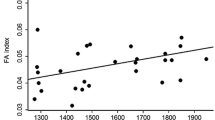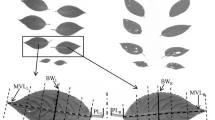Abstract
Fluctuating asymmetry (FA) is a parameter to measure developmental stability in plants, which can be altered by disturbances, pollution, and biotic factors such as herbivory. We evaluated the effects of environmental stress and herbivory on the FA levels in individuals of Tibouchina heteromalla (Melastomataceae) that occur in natural and undergoing restoration areas in rupestrian grasslands at Serra do Cipó, Brasil. Individuals were collected and measured in seven restored and five natural areas, totalizing 240 individuals. We found that individuals in restored areas had greater leaf area, higher levels of insect herbivory and FA compared to individuals that occurred in natural areas. In both environments, the proportion of individuals with leaf damage caused by herbivory was higher than the proportion of undamaged individuals. In addition, FA was positively correlated with herbivory and total leaf area in both restored and natural areas. These results suggest that more favorable conditions in the restored areas enhanced leaf growth, resulting in higher FA.




Similar content being viewed by others
References
Boeger MRT, Gluzezak RM (2006) Adaptações estruturais de sete espécies de plantas para as condições ambientais da área de dunas de Santa Catarina, Brasil. Iheringia 61:73–82
Brown VK, Lawton JH (1991) Herbivory and the evolution of leaf size and shape. Philos Trans R Soc Lond B 333:265–272
Coley PD, Bryant JP, Chapin FS III (1985) Resource availability and plant antiherbivore defense. Science 230:895–899
Cornelissen T, Stiling P (2005) Sex-biased herbivory: a meta-analysis of the effects of gender on plant-herbivore interactions. Oikos 111:488–500
Cornelissen T, Stiling P (2011) Similar responses of insect herbivores to leaf fluctuating asymmetry. Arthropod Plant Interact 5:59–69
Cornelissen T, Stiling P, Drake B (2003) Elevated CO2 decreases leaf fluctuating asymmetry and herbivory by leaf miners on two oak species. Glob Chang Biol 10:27–36
Costa FV, Pinheiro IF, Braga LL, Perillo L, Neves FS, Leite LO, Silva BL, Ribeiro LC, Fernandes GW, Cuevas-Reyes P (2012) Fluctuating asymmetry and herbivory in two ontogenetical stages of Chamaecrista semaphora in restored and natural environments. J Plant Interact 8:179–186
Cuevas-Reyes P, Oyama K, González-Rodríguez A, Fernandes GW, Mendoza-Cuenca L (2011) Contrasting herbivory patterns and leaf fluctuating asymmetry in Heliocarpus pallidus between different habitat types within a Mexican tropical dry forest. J Trop Ecol 27:383–391
Cuevas-Reyes P, Gilverti L, González-Rodríguez A, Fernándes GW (2013) Patterns of herbivory and fluctuating asymmetry in Solanum lycocarpum St. Hill (Solanaceae) along an urban gradient in Brazil. Ecol Indic 24:557–561
Escós J, Alados CL, Emlen JM (1997) The impact of grazing on plant fractal architecture and fitness of a Mediterranean shrub Anthyllis cytisoides L. Funct Ecol 11:66–78
Feeny P (1976) Plant apparency and chemical defense. Recent Adv Phytochem 10:1–40
Fernandes GW, Price PW (1991) Comparisons of tropical and temperate galling species richness: the role of environmental harshness and plant nutrient status. In: Price PW, Levinsohn TM, Fernandes GW, Benson WW (eds) Plant-animal interactions: evolutionary ecology in tropical and temperate regions. Wiley, New York, pp 91–115
Fernandes GW, Santos R, Barbosa NOU, Almeida HA, Varvalho V, Angrisano P (2015) Occurrence of non-native and exotic plants in restored areas of rupestrian grasslands. Planta Daninha (in press)
Freeman DC, Brown ML, Duda JJ, Graham JH, Emlen JM, Krzysik AJ, Balbach H, Kovacic DA, Zak JC (2004) Developmental instability in Rhus Copallinum L.: multiple stressors, years, and responses. Int J Plant Sci 165(1):53–63
Givnish TJ (ed) (1986) On the economy of plant form and function. Cambridge University Press, Cambridge, p 717
Graham JH, Raz S, Hel-Or H, Nevo E (2010) Fluctuating asymmetry: methods, theory, and applications. Symmetry 2:466–540
Guimarães PJF, Martins AB (1997) Tibouchina sect. Pleroma (D. Don) Cogn. (Melastomataceae) no Estado de São Paulo. Rev Bras Bot 20:11–33
Hilario RR, Castro SAB, Ker FTO, Fernandes GW (2011) Unexpected effects of pigeon-peas (Cajanus cajan) in the restoration of rupestrian fields. Planta Daninha 29:717–723
Hódar JA (2002) Leaf fluctuating asymmetry of Holm oak in response to drought under contrasting climatic conditions. J Arid Environ 52:233–243
Horn HS (1971) The adaptive geometry of trees. Princeton University Press, Princeton, p 147
James SA, Bell DT (2001) Leaf morphological and anatomical characteristics of heteroblastic Eucalyptus globosus ssp. globosus (Myrtaceae). Aust J Bot 49:259–269
Kursar TA, Coley PD (2003) Convergence in defense syndromes of young leaves in tropical rainforests. Biochem Syst Ecol 21:929–949
Larcher W (2006) Ecofisiologia Vegetal. RIMA, São Carlos, p 531
Lempa K, Martel J, Koricheva J, Haukioja E, Ossipov V, Ossipova S, Pihlaja K (2000) Covariation of fluctuating asymmetry, herbivory, and chemistry during birch leaf expansion. Oecologia 122:354–360
Lewis MC (1972) The physiological significance of variation in leaf structure. Sci Prog 60:25–51
Madeira JA, Fernandes GW (1999) Reproductive phenology of sympatric Chamaecrista taxa of Chamaecrista (Leguminosae) in Serra do Cipó, Brazil. J Trop Ecol 15:463–479
Martel J, Lempa K, Haukioja E (1999) Effect of stress and rapid growth on fluctuating asymmetry and insect damage in birch leaves. Oikos 86:208–216
McKey D, Waterman PG, Mbi CN, Gartlan JS, Struhsaker TT (1978) Phenolic content of vegetation in two African rain forests: ecological implications. Science 202:61–64
Møller AP (1995) Leaf-mining insects and fluctuating asymmetry in elm Ulmus glabra leaves. J Anim Ecol 64(6):697–707
Møller AP, De Lope F (1998) Herbivory affects developmental instability of stone oak, Quercus rotundifolia. Oikos 82:246–252
Møller AP, Eriksson M (1994) Patterns of fluctuating asymmetry in flowers: implications for sexual selection in plants. J Evol Biol 7:97–113
Møller AP, Shykoff P (1999) Morphological developmental stability in plants: patterns and causes. Int J Plant Sci 160:S135–S146
Møller AP, Swaddle JP (1997) Asymmetry, developmental stability and evolution. Oxford University Press, Oxford, p 285
Negreiros D, Moraes MLB, Fernandes GW (2008) Caracterização da fertilidade dos solos de quatro espécies de leguminosas de campos rupestres, Serra do Cipó, MG, Brasil. R C Suelo Nutr Veg 8:30–39
Palmer AR, Strobeck C (1986) Fluctuating asymmetry: measurement, analysis and patterns. Annu Rev Ecol Evol Syst 17:391–421
Price PW (1997) Insect ecology. Wiley, New York, p 867
Rapini A, Ribeiro PL, Lambert S, Pirani JR (2008) A flora dos campos rupestres da Cadeia do Espinhaço. Megadiversidade 4:15–23
Ribeiro KT, Fernandes GW (2000) Patterns of abundance of a narrow endemic species in a tropical and infertile montane habitat. Plant Ecol 147:205–218
Root RB (1973) Organization of a plant-arthropod association in simple and diverse habitats: the fauna of colards (Brassica oleracea). Ecol Monogr 43:95–124
Schlichting CD (1986) The evolution of phenotypic plasticity in plants. Annu Rev Ecol Syst 17:667–693
Souza VC, Lorenzi H (2005) Botânica Sistemática: Guia ilustrado para identificação das famílias de Angiospermas da flora brasileira, baseado em APGII. Instituto Plantarum, Nova Odessa, p 291
Telhado C, Esteves D, Cornelissen T, Fernandes GW, Carneiro MA (2010) Insect herbivores of Coccoloba cereifera do not select asymmetric plants. Environ Entomol 39:849–855
Tripathi N, Singh RS (2008) Ecological restoration of mined-out areas of dry tropical environment. India. Environ Monit Assess 146:325–337
White TCR (1984) The abundance of invertebrate herbivory in relation to the availability of nitrogen in stressed food plants. Oecologia 63:90–105
Wiggins DA (1997) Fluctuating asymmetry in Colophospermum mopane leaves and oviposition preference in an African silk moth Imbrasia belina. Oikos 79:484–488
Zakharov VM, Graham JH (Eds) (1992) Developmental stability in natural populations. Acta Zool Fenn 191:1–200
Zvereva E, Kozlov M, Haukioja E (1997) Stress responses of Salix borealis to pollution and defoliation. J Appl Ecol 34:1387–1396
Acknowledgments
We thank A Efremova and two anonymous reviewers for helpful comments on initial versions of this manuscript. We acknowledge the support from Conselho Nacional de Pesquisas (CNPq), Fundação de Amparo à Pesquisa do Estado de Minas Gerais (FAPEMIG), Reserva Vellozia, and DER-MG. Cuevas-Reyes P thanks Coordinación de la Investigación Científica de la UMSNH for their generous support.
Author information
Authors and Affiliations
Corresponding author
Additional information
Edited by Kleber Del Claro – UFU
Rights and permissions
About this article
Cite this article
Fernandes, G.W., de Oliveira, S.C.S., Campos, I.R. et al. Leaf Fluctuating Asymmetry and Herbivory of Tibouchina heteromalla in Restored and Natural Environments. Neotrop Entomol 45, 44–49 (2016). https://doi.org/10.1007/s13744-015-0342-1
Received:
Accepted:
Published:
Issue Date:
DOI: https://doi.org/10.1007/s13744-015-0342-1




